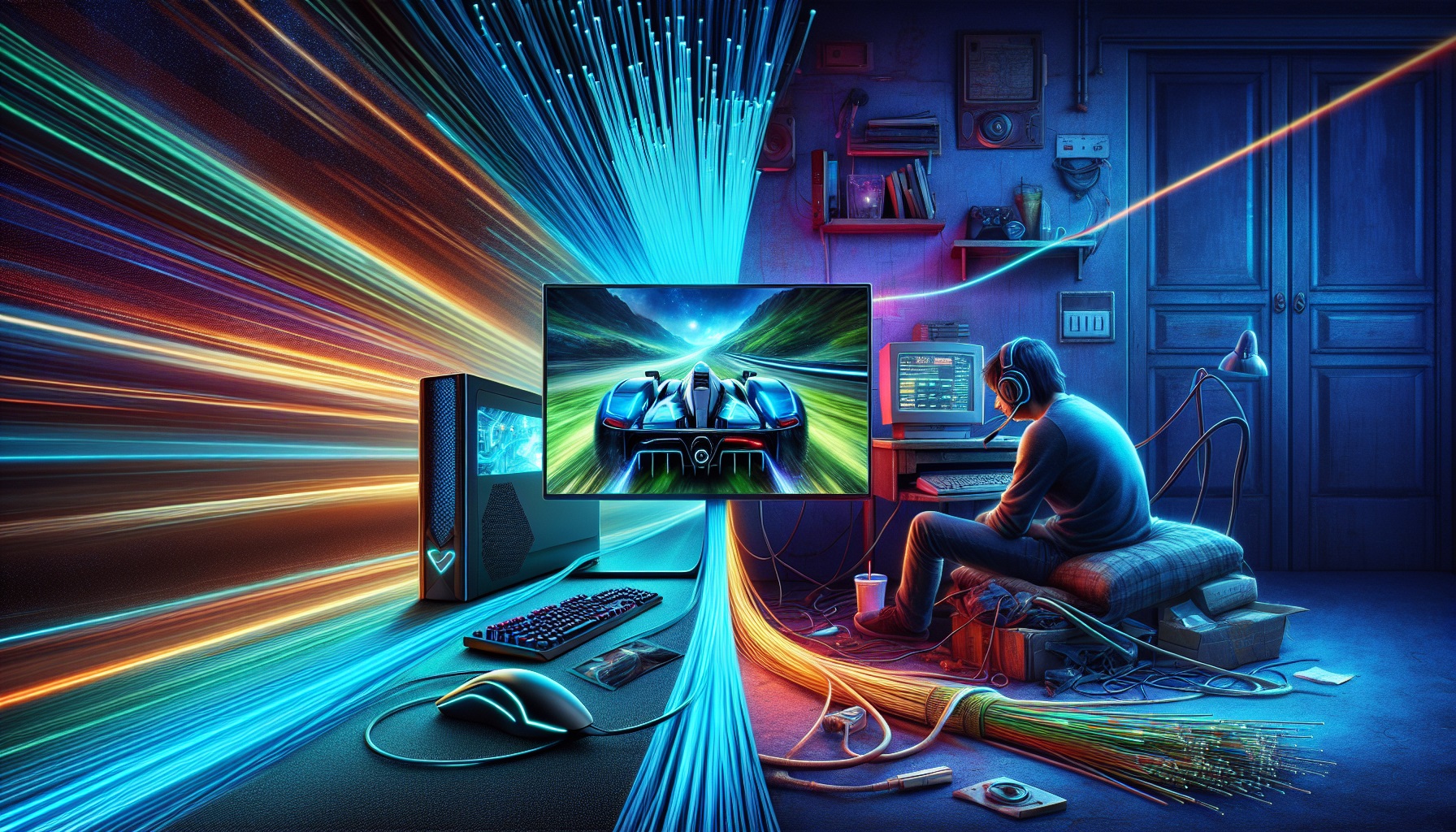Is 300 Mbps Good for Gaming? An In-Depth Analysis

In the world of online gaming, internet speed plays a crucial role in determining the quality of the gaming experience. Gamers often wonder if their internet connection is fast enough to support their favorite titles and provide smooth gameplay. One common question that arises is: is 300 Mbps good for gaming? This speed, offered by many internet service providers, has become increasingly popular among households with multiple smart home devices and high-speed internet needs.
To answer this question, it’s essential to consider various factors that affect gaming performance. Download speed, latency, and ping are all important elements that can impact the gaming experience. Additionally, the type of internet connection, such as fiber optic or WiFi, can make a difference. This article will explore whether 300 Mbps is sufficient for gaming, examine the factors beyond speed that influence gameplay, and provide insights into optimizing your internet setup for the best possible gaming performance.
Understanding Internet Speed for Gaming
What is Mbps?
Mbps, or megabits per second, measures the rate at which data can be transferred from one point to another [1]. It’s typically referred to as “download speed” when data moves from the internet to your computer, and “upload speed” when data goes from your computer to the internet [1]. For gaming, both speeds play crucial roles in determining the quality of your online experience.
Importance of Download vs Upload Speed
Download speed determines how quickly data can be transferred from the gaming server to your device, while upload speed affects how fast your device sends data back to the server [1]. For online multiplayer games, a slow upload speed can cause lag and make the game unplayable [1]. Most video game console manufacturers recommend at least 3 Mbps download speed and 0.5 Mbps to 1 Mbps upload speed as a generally “good internet speed” [2].
The Role of Latency in Gaming
Latency, also known as ping rate, measures how long it takes for a packet of data to travel from one point to another [1]. In gaming, this translates to the time between a player’s input and the corresponding action in the game [3]. A good ping rate is crucial for responsive gameplay, with 100ms or less considered acceptable, and 20ms to 40ms being optimal [1]. High latency can lead to noticeable delays and even packet loss, significantly impacting the gaming experience [3].
Is 300 Mbps Sufficient for Gaming?
Minimum Speed Requirements for Popular Games
Most video game consoles recommend at least 3 Mbps download speed and 0.5 Mbps to 1 Mbps upload speed for a good gaming experience [2]. Specific requirements vary by platform: Xbox One needs 3 Mbps, PlayStation 5 requires 5 Mbps, Nintendo Switch recommends 3 Mbps, and PC gaming typically needs 3 to 6 Mbps [4].
Gaming Performance at 300 Mbps
A 300 Mbps internet connection is more than sufficient for gaming. This speed allows for lag-free gameplay, even for competitive multiplayer games [5]. It’s well above the recommended 15-25 Mbps download speed and 5 Mbps upload speed for optimal gaming [2]. With 300 Mbps, gamers can play without interruption and simultaneously perform other tasks like streaming or downloading [5].
Handling Multiple Devices
A 300 Mbps connection can support around 20-30 devices simultaneously, depending on their usage [6]. It can handle up to a dozen devices for web browsing and social media, or up to four devices streaming 4K video concurrently [5]. This bandwidth is ample for gaming while other household members use the internet, ensuring a smooth gaming experience even with multiple connected devices.
300 Mbps vs Other Common Internet Speeds for Gaming
Comparison with 100 Mbps
While 100 Mbps is generally sufficient for online gaming, 300 Mbps offers more flexibility for households with multiple users. Online games typically require only 5 Mbps or faster connection 6. However, 300 Mbps allows for smoother gameplay, especially when other devices are consuming content simultaneously 7.
Comparison with 500 Mbps
A 500 Mbps plan provides slightly more advantages than 300 Mbps, particularly for households with 10 or more people. It offers maximum download speeds of 480 Mbps and upload speeds of 50 Mbps, making it suitable for console and cloud gaming on multiple devices 7. However, for most gaming purposes, the difference between 300 Mbps and 500 Mbps may not be noticeable 8.
Comparison with 1 Gbps
1 Gbps (1000 Mbps) plans are designed for professional multiplayer gaming and streaming. They offer maximum download speeds of 950 Mbps and upload speeds of 90-100 Mbps 7. While this speed can support 8-10 multiplayer gaming sessions at 4K (60 FPS), it may be excessive for most households unless they have numerous people consuming high-bandwidth content simultaneously 7.
Real-World Gaming Performance at 300 Mbps
Online Multiplayer Games
A 300 Mbps connection is more than sufficient for online gaming. Most games require only 5 Mbps or faster 6. However, latency is more crucial than bandwidth for a smooth gaming experience. A connection with lower ping (under 50 ms) is preferable to one with higher bandwidth but higher latency 9. For competitive gaming, stability and low jitter are also essential factors.
Game Downloads and Updates
While 300 Mbps isn’t necessary for gameplay, it significantly enhances the download experience. Modern games and updates can be massive, often exceeding 20GB 6. With a 300 Mbps connection, gamers can download large files quickly, reducing wait times and allowing for more immediate gameplay. This speed is particularly beneficial for those who frequently update or download new games.
Cloud Gaming Services
Cloud gaming services typically require 30-40 Mbps for optimal performance 9. A 300 Mbps connection easily meets this requirement, providing ample bandwidth for high-quality streaming. However, as with online gaming, latency remains a critical factor. Cloud gaming performance depends more on a stable connection with low ping than on raw download speed 9.
Analyzing 300 Mbps for Different Gaming Scenarios
Single Player vs Multiplayer Gaming
A 300 Mbps connection is more than sufficient for both single-player and multiplayer gaming. Most online games require only 2-10 Mbps for a good experience 1. The primary factor affecting gameplay is latency, not bandwidth. Latency, measured in milliseconds, determines how quickly data travels between your device and the game server 3.
Streaming While Gaming
With 300 Mbps, gamers can easily stream their gameplay on platforms like YouTube or Twitch while playing 4. This speed allows for higher quality streaming and simultaneous activities such as gaming, streaming, and downloading 4. It provides ample bandwidth for multiple devices to game online concurrently 4.
Competitive Gaming Requirements
For competitive gaming, 300 Mbps exceeds the necessary speed. Most gaming platforms recommend much lower speeds. For example, Xbox suggests a minimum of 3 Mbps download and 0.5 Mbps upload 1. However, for a consistent online experience, it’s recommended to have at least 5 Mbps download and 3 Mbps upload with latency under 100 ms 1.
Optimizing Your 300 Mbps Connection for Gaming
Choosing the Right Router
For optimal gaming performance, selecting a suitable router is crucial. Gaming routers often feature custom lighting and built-in gaming tools 5. Look for routers with three bands, high stream count, and multiple Ethernet ports 5. The Asus RT-AX86U is a top pick, offering Wi-Fi 6 support and gamer-centric features 6.
Wired vs Wireless Connections
Ethernet connections provide consistent speeds and low latency, making them ideal for gaming 7. A wired connection can offer up to 1 Gbps speeds, surpassing the reliability of a 300 Mbps Wi-Fi connection 8. For those who must use Wi-Fi, opt for the 5 GHz band and higher channels to avoid interference 7.
Prioritizing Gaming Traffic
To ensure smooth gameplay, prioritize gaming traffic on your network. Many routers offer Quality of Service (QoS) features to prioritize gaming data 9. This can help maintain low ping even when other devices are using the network for activities like streaming 10. Some routers allow you to set priority for specific devices or game ports 10.
Factors Affecting Gaming Performance Beyond Speed
Hardware Limitations
Gaming performance isn’t solely dependent on internet speed. Hardware plays a crucial role. Outdated components, such as older GPUs or CPUs, can significantly impact gameplay [7]. For instance, trying to run Alan Wake 2 on NVIDIA GPUs older than the 2000 series may result in poor performance. Bottlenecks, where either the CPU or GPU reaches 100% workload, can also hinder smooth gameplay [7].
Server Location
The physical location of gaming servers has a substantial impact on latency. Due to the speed of light limitation, data traveling over longer distances experiences increased delay [8]. Additionally, data packets may encounter more network hops, each introducing processing delays [8]. Server proximity to players can result in faster response times and quicker page loading, enhancing overall gaming experience [9].
Network Congestion
Network congestion occurs when data traffic exceeds the network’s capacity to handle it [10]. This can lead to increased latency, jitter, and packet loss, all of which negatively affect gaming performance [11]. Factors contributing to congestion include inadequate bandwidth, network configuration issues, and unnecessary traffic [11]. Implementing quality of service measures and traffic shaping algorithms in gaming routers can help mitigate these issues [12].
Common Misconceptions
Many gamers overestimate the importance of download speed alone. In reality, online games require minimal data transfer during gameplay 1. The interaction between your device and the game server primarily involves exchanging small packets of data, such as player location and input commands 1. Upload speed, often overlooked, is equally important for sending your actions to the server 1. A balanced internet connection with low latency and minimal packet loss is more valuable for gaming than raw speed alone 2.
Conclusion
A 300 Mbps internet connection proves to be more than sufficient to meet the demands of modern gaming. This speed not only allows for smooth, lag-free gameplay across various platforms but also provides ample bandwidth to support multiple devices simultaneously. However, it’s crucial to remember that internet speed is just one piece of the puzzle when it comes to optimizing the gaming experience.
Other factors, such as hardware capabilities, server locations, and network congestion, have a significant impact on overall gaming performance. To get the most out of a high-speed connection, gamers should consider upgrading their hardware, choosing servers closer to their location, and taking steps to reduce network congestion. By addressing these aspects alongside a robust internet connection, players can create an ideal environment to enjoy their favorite games to the fullest.
References
[1] – https://www.swoop.com.au/blog/good-internet-speed-for-gaming/
[2] – https://www.xfinity.com/hub/internet/internet-speed-for-gaming
[3] – https://www.t-mobile.com/home-internet/the-signal/speed/what-is-latency-in-gaming
[4] – https://www.business.att.com/resources/knowledge-center/what-internet-speed-is-best-for-gaming.html
[5] – https://www.forbes.com/home-improvement/internet/is-300mbps-fast/
[6] – https://www.quora.com/How-many-devices-can-a-300-Mbps-router-support
[7] – https://www.quora.com/What-does-hardware-limitation-mean-in-the-context-of-gaming-Can-someone-provide-an-explanation
[8] – https://hostscore.net/learn/what-is-latency-impact-of-server-locations-to-your-website-performance/
[9] – https://www.linkedin.com/pulse/impact-server-location-shared-hosting-performance-vimal-thakur-pntkc
[10] – https://www.ir.com/guides/network-congestion
[11] – https://obkio.com/blog/what-is-network-congestion/
[12] – https://www.g2a.com/news/features/top-7-factors-impacting-ping-lag-in-online-gaming/

